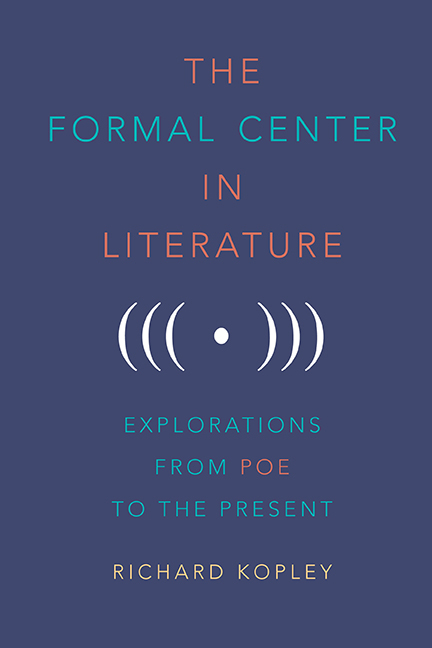Book contents
- Frontmatter
- Dedication
- Contents
- Acknowledgments
- Introduction
- 1 “Mournful and Never-Ending Remembrance” in Edgar Allan Poe's The Narrative of Arthur Gordon Pym
- 2 Retracing Our Steps in Edgar Allan Poe's “The Man of the Crowd”
- 3 “Scrutinizing the Parchment More Closely”: The Form of “The Gold-Bug” and Its Relationship to That of the Dupin Tales
- 4 Form and Reform in Nathaniel Hawthorne's “Earth's Holocaust”
- 5 The Circle and Its Center in Herman Melville's “Bartleby, the Scrivener”
- 6 Chiasmus in Henry David Thoreau's Walden
- 7 The Mythological Centers of Lewis Carroll's Alice Books
- 8 Table as Text in James Joyce's “The Dead”
- 9 The Structure of Sherwood Anderson's “Hands”
- 10 The Architecture of Ernest Hemingway's “The Three-Day Blow”
- 11 Balance in Dashiell Hammett's The Maltese Falcon
- 12 Framing Caesar in Raymond Chandler's The Big Sleep
- 13 The Ridge of the Domino in Patricia Highsmith's Strangers on a Train
- 14 The “X in the Air” in Joyce Carol Oates's “Where Are You Going, Where Have You Been?”
- 15 The Hybrid Center of Zadie Smith's White Teeth
- Notes
- Bibliography
- Index
4 - Form and Reform in Nathaniel Hawthorne's “Earth's Holocaust”
Published online by Cambridge University Press: 14 June 2019
- Frontmatter
- Dedication
- Contents
- Acknowledgments
- Introduction
- 1 “Mournful and Never-Ending Remembrance” in Edgar Allan Poe's The Narrative of Arthur Gordon Pym
- 2 Retracing Our Steps in Edgar Allan Poe's “The Man of the Crowd”
- 3 “Scrutinizing the Parchment More Closely”: The Form of “The Gold-Bug” and Its Relationship to That of the Dupin Tales
- 4 Form and Reform in Nathaniel Hawthorne's “Earth's Holocaust”
- 5 The Circle and Its Center in Herman Melville's “Bartleby, the Scrivener”
- 6 Chiasmus in Henry David Thoreau's Walden
- 7 The Mythological Centers of Lewis Carroll's Alice Books
- 8 Table as Text in James Joyce's “The Dead”
- 9 The Structure of Sherwood Anderson's “Hands”
- 10 The Architecture of Ernest Hemingway's “The Three-Day Blow”
- 11 Balance in Dashiell Hammett's The Maltese Falcon
- 12 Framing Caesar in Raymond Chandler's The Big Sleep
- 13 The Ridge of the Domino in Patricia Highsmith's Strangers on a Train
- 14 The “X in the Air” in Joyce Carol Oates's “Where Are You Going, Where Have You Been?”
- 15 The Hybrid Center of Zadie Smith's White Teeth
- Notes
- Bibliography
- Index
Summary
LIKE POE, Nathaniel Hawthorne created works of fiction with both central chiasmus and central parallelism. I have discussed elsewhere the central chiasmus of Hawthorne's The Scarlet Letter (1850)—“an immense letter,—the letter A”—occurring in the central scaffold scene and framed by the first and last scaffold scenes and by abundant symmetrical language. I will consider here the framed central parallelism of his 1844 sketch “Earth's Holocaust.”
In 1839 or 1840, Hawthorne wrote in one of his notebooks, “A bonfire to be made of the gallows and of all symbols of evil” (CE 8:185). A few years later, in 1842 or 1843, he elaborated on this idea:
When the reformation of the world is complete, a fire shall be made of the gallows; and the Hangman shall come and sit down by it, in solitude and despair. To him shall come the Last Thief, the Last Prostitute, the Last Drunkard, and other representatives of past crime and vice; and they shall hold a dismal merry-making, quaffing the contents of the Drunkard's last Brandy Bottle. (CE 8:237)
In late 1843 or early 1844, Hawthorne developed these ideas into a remarkable story, “Earth's Holocaust.” Imagining a modern-day “bonfire of the vanities”—that 1497 effort by Girolamo Savonarola to burn all that could lead to sin—he critiqued contemporary reform and suggested the possibility of its ultimate futility. Yet he also offered a qualified support for the destruction of the gallows. The story was published in Graham's Magazine in May 1844 and later appeared in Mosses from an Old Manse in 1846.
In this cautionary tale, people gather at a spot on the American prairie to create a huge bonfire to destroy the world's “accumulation of worn-out trumpery” (CE 10:381). The narrator, an American author—perhaps a somewhat naïve version of Hawthorne himself— attends, seeking “some profundity of moral truth” (CE 10:381). He occasionally talks with a fellow observer, “a grave man, fifty years old or thereabout” (CE 10:382). They witness the destruction of objects of heraldry, objects of royalty, as well as all the liquor in the world. The “Last Toper” (CE 10:387)—the “Last Drunkard” of Hawthorne's note—exclaims his distress but manages to steal a bottle of brandy. Coffee, tea, and tobacco are consigned to the fire, and then individuals contribute their own fuel, from a purse to pen and paper.
- Type
- Chapter
- Information
- The Formal Center in LiteratureExplorations from Poe to the Present, pp. 35 - 40Publisher: Boydell & BrewerPrint publication year: 2018
- 1
- Cited by



